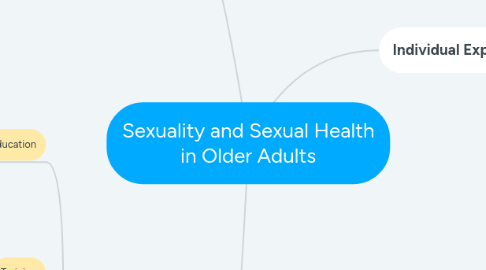
1. Societal Impacts & Expectations
1.1. Misinformation
1.1.1. Ageist Beliefs
1.1.1.1. Perpetuating Stereotypes
1.1.1.2. Shame
1.1.1.3. Low Expectations of Health & Happiness of Older Adults
1.1.1.4. Power Imbalances
1.1.2. Lack of Research
1.1.2.1. Heteronormative Assumptions in Current Research
1.1.2.2. Priorities Set on other Aspects of Health of Older Adults
1.1.2.3. Lack of Funding
1.1.3. Lack of Training/Education of Healthcare Providers
1.1.3.1. Perpetuates Invisibility of Older Adults
1.1.3.2. Lack of Funding
1.1.3.3. Time Constraints
1.1.3.4. Personal Beliefs of Providers
1.1.4. Lack of Knowledge
1.1.4.1. Increased STI/STD Rates of Older Adults
1.2. "Don't Ask Don't Tell" Attitudes and Practices
1.2.1. Older Adults Viewed as Sexually Invisible
1.2.2. Heteronormative Assumptions in Residential Environments
1.2.3. Fear of Offending & Discomfort of Topic
1.2.4. Ethical Considerations
1.2.4.1. Consent
1.2.5. Lack of Support
1.3. Cultural Expectations/Impacts
1.3.1. Potential Heteronormative Expectations
1.3.2. Gender Roles/Expectations
1.3.3. Norms Regarding Sharing/Communication
2. Interventions
2.1. Education
2.1.1. Educate General Public
2.1.2. Reduces Shame/Stigma
2.1.3. Dispels Myths/Misinformation
2.2. Training
2.2.1. Social Service & Healthcare Professional Training
2.2.2. Funding Allocated to Training
2.2.3. Reduces Shame/Stigma
2.2.4. Provides Professionals with Approaches to Support
2.3. Support of Older Adults
2.3.1. Goal Setting
2.3.1.1. Based on Individual's Needs/Wants
2.3.1.1.1. Promotes Self-Efficacy
2.3.2. Open and Respectful Dialogues
2.3.2.1. Promote Dignity in Individual
2.3.3. Counselling/Therapy
2.3.3.1. Communication
2.3.3.2. Relationship Goals
2.3.3.3. Personal Goals
2.3.4. Education
2.3.4.1. Safe Sex Practices
2.3.4.2. Consent
2.3.4.2.1. Capacity Considerations
2.3.4.3. Dispel myths and misinformation
2.3.4.4. Reduces Shame
2.3.5. Assessments
2.3.5.1. Identify Challenges
2.3.5.1.1. Address Potential Solutions
2.3.6. Connection to Community Supports/Services
2.3.6.1. Reduces Social Isolation
2.3.6.2. Promotes Self-Efficacy
2.3.7. Connection to Social Groups
2.3.7.1. Reduces Social Isolation
2.3.7.2. Promotes Self-Esteem
2.3.8. Education
3. Individual Experiences
3.1. Mental/Emotional Health
3.1.1. Connection & Intimacy
3.1.1.1. Loss of Partners
3.1.1.2. Reduced Social Contact
3.1.1.3. Affection Needs
3.1.1.4. Lonliness
3.1.2. Self-Esteem
3.1.2.1. Body Image
3.1.2.2. Self- Agency
3.1.2.3. Confidence
3.1.2.4. Feeling Less Desirable
3.1.3. Experiences of Ageism
3.1.3.1. Shame
3.1.3.2. Lowered Expectations of Health/Happiness
3.1.3.3. Assumptions of Sexual & Gender Identity/Expression
3.1.3.4. Stigma
3.1.4. Religious & Spiritual Beliefs
3.1.4.1. Expectations of Sexual Dyad
3.1.4.2. Fear of Judgement
3.1.4.3. Social & Community Support System
3.1.5. Beliefs Regarding Aging and Sexuality
3.1.5.1. Expectation of Reduced Sexual Activity
3.1.5.2. May No Longer View Self as Sexual Being
3.2. Physical Health
3.2.1. Changes to Physical Body
3.2.1.1. Reduced Blood Circulation
3.2.1.1.1. Pain During Sexual Intimacy
3.2.1.1.2. Impotency
3.2.1.1.3. Reduction in Pleasure
3.2.1.2. Hormonal Changes
3.2.1.2.1. Changes to Sexual Drive/Arousal Responses
3.2.1.2.2. Pain During Sexual Intimacy
3.2.1.3. Sensory Changes
3.2.1.3.1. Reduction of sight, smell, taste, hearing, touch, vestibular, proprioception
3.2.1.3.2. Impacts on Communication with Sexual Partner/s
3.2.2. Impacts of Illness
3.2.2.1. Challenges with Mobility/Movement
3.2.2.2. Chronic & Acute Pain
3.2.2.3. Diseases
3.2.2.3.1. Medication Side Effects
3.2.2.3.2. Post-Surgery Effects
3.2.2.3.3. Symptoms of Illnesses
3.2.2.4. Incontinence
3.2.2.4.1. Shame
3.2.2.4.2. Physical Barrier to Intimacy
